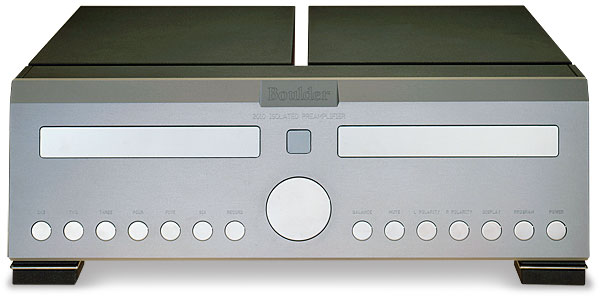Rolling Boulders

 The no-compromise 2010 preamp and 2020 DAC are part of the US manufacturer's ongoing 2000 series project. Martin Colloms listens
The no-compromise 2010 preamp and 2020 DAC are part of the US manufacturer's ongoing 2000 series project. Martin Colloms listens
Boulder's founder and chief engineer Jeff Nelson gained his first audio engineering experience with studio mixing desks and the design of a professional cartridge tape unit. This led to a constructive interchange with the late Deane Jensen, the audio transformer wizard and the originator of a classic 'operational amplifier'. This was not an integrated circuit but one implemented at good power and wide bandwidth via the use of discrete devices.
Luxury Unlimited
Jensen's design comprised a stable low-noise gain block which had wide applications for audio components, including DACs, preamplifiers and power amplifiers. Jeff made this concept his own with further refinements in the choice of semiconductors and performance. This circuit module is the core technology for Boulder designs.
Based, as you might guess, in Boulder, Colorado, the company now produces an established line of pre- and power amps. However, in the 2000 series, price is almost no object, and finish and facilities have been taken to the limit of what is practical for luxury high fidelity.

There are enough very wealthy audiophiles in the world to make such an endeavour worthwhile, a market also tapped by Rowland Research, Mark Levinson and Cello. This is yet another level of price beyond the costly, yet still mainstream audiophile, creations of Krell, Audio Research and Conrad- Johnson. As a pair, the Boulder units reviewed here cost £50,000 – and this does not include a CD transport or a power amplifier! Both are promised for the near future.
Boulder 2020 DAC
Matching the 2010 line controller, the 2020 is a full-size, luxurious digital-to-analogue converter with some special facilities. A comprehensive remote control is provided, built in modular form. Its keyboard allows the remote selection from six digital inputs, four of these being in balanced format (a Boulder unbalance adapter is also available for coaxial connection) plus two optical Toslink and 'ST Glass'. In addition the 2020 has two digital outputs, for monitoring of the selected source, and a separated record output section.

Conventional balance controls can only adjust the relative loudness of the two channels, but on the 2020 an offset speaker and/or listener position may be corrected accurately by adjusting the time delay of one channel relative to the other, to correct for the discrepancy in distances to the listener. The display may be set for inches, centimetres or milliseconds and can correct substantial offsets of several feet. Even half-inch adjustments can be audible – the ultimate balance control for couch potatoes!
Cloud Nine
A separate power supply (an outwardly identical unit powers the 2010 line preamplifier) is linked to the connector by a total of three cable sets, the third of these supplying the DAC's digital acquisition and microprocessor sections. As for the converters proper, these are located in diecast boxes positioned above the main chassis, and easily demounted from it. This makes upgrade or replacement a simple procedure.

Meanwhile, input switching is relay-controlled, S/PDIF signals being acquired and locked by the Crystal 84-series ADIC Signal processing which includes an NPC digital filter, an FIR type with 20-bit output (8x oversampling). After the filter comes the Boulder anti-jitter circuit, a phase-lock crystal oscillator which resynchronises the data word clock. Drive from the lower chassis to the DAC units proper is via a digital balanced interface, driving an array of five paralleled Burr-Brown 1702 converters. Next comes the first appearance of Boulder's powerful discrete op-amp module, the top- specification 993 unit performing the current summing for the five DACs to a stable output voltage.
Two more 993s (per channel) each operate as a three-pole Bessel filter, this leading to another pair of 993s used for the balanced audio output. At this point, the signal quality is then equal for the balanced and normal outputs, at a low 100ohm rated impedance, of 2V (4V balanced).
![]() 2020 Sound Quality
2020 Sound Quality
A wholehearted commitment to the truth was displayed by the 2020, which was one of the most neutral and even-handed decoders I've ever heard. It was completely confident from the lowest bass to the highest treble, in regard to precision, uniformity, lack of distortion and high clarity. It set very high standards for all these, devoid of coloration, grain or any false emphasis, anywhere. The effect was one of majestic calm in a big system, a result which in context I'd experienced with Cello electronics a decade ago, in this Boulder perhaps tempered by the grainless quality expressed in Jeff Rowland designs.
The 2020 had good rhythmic control and timing, holding onto the musical flow and yet dynamics seemed a tad muted. With high resolution generally evident, the sound still lacked the ability to express the full transient attack and air possible, giving a feeling of 'quietness' and asking for the volume to be raised to wake things up. In practice the sound was so smooth that this poses no problem.


















































